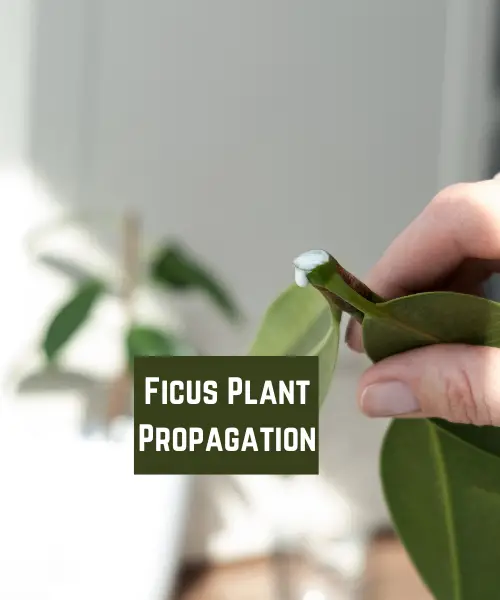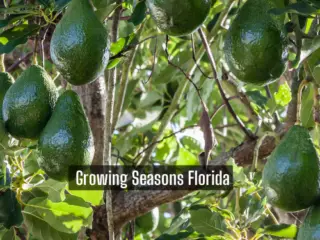The ficus, with its lush foliage and air-purifying qualities, has become a staple in many households and offices worldwide.
However, did you know that these resilient plants can be easily propagated, allowing you to multiply your green companions while saving money?
We will delve into the fascinating world of ficus plant propagation in this in-depth guide, giving you the tools you need to grow new plants right in your own house.
The Ficus Plant Family
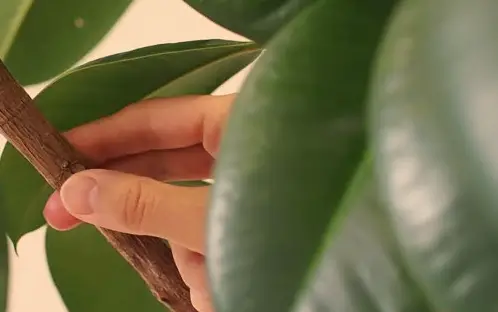
Ficus, also known as figs, encompasses a vast genus of over 800 species, ranging from towering trees to compact houseplants. Some of the most popular ficus varieties for indoor cultivation include the ficus benjamina (weeping fig), ficus elastica (rubber plant), and ficus lyrata (fiddle-leaf fig). Each species has its own unique characteristics, but the propagation methods remain relatively consistent across the genus.
Propagation Methods for Ficus Plants
Ficus plants can be propagated through various techniques, each with its own advantages and considerations. In this section, we’ll explore the three most common methods: stem cuttings, air layering, and seed propagation.

Ficus Plant Propagation
1. Stem Cuttings
Stem cutting propagation is perhaps the most straightforward and widely used method for ficus plants. This technique involves taking a healthy stem section from the parent plant and encouraging it to develop roots, ultimately forming a new, independent plant.
Step-by-Step Guide to Stem Cutting Propagation:
- Select a healthy stem. Choose a stem that is at least 6 inches long, with several leaf nodes (points where leaves emerge from the stem). Ideally, the stem should be semi-hardwood, neither too soft nor too woody.
- Remove the lower leaves: Strip off the lower leaves, leaving only the top few leaves intact.
- Cut the stem: Using a sharp, clean knife or pruning shears, make a diagonal cut just below a leaf node.
- Prepare the rooting medium: Fill a well-draining container with a suitable rooting medium, such as a mixture of perlite, vermiculite, and peat moss.
- Apply rooting hormone (optional): Dipping the cut end of the stem in a rooting hormone can promote faster root development, but it’s not strictly necessary.
- Plant the cutting: Create a hole in the rooting medium and insert the cut end of the stem, gently firming the medium around it.
- Maintain moisture and warmth: Keep the rooting medium moist but not waterlogged, and place the container in a warm, well-lit area out of direct sunlight.
- Monitor for root development: After several weeks, gently tug on the cutting; if you feel resistance, it’s an indication that roots have formed.
- Transplant and care for the new plant: Once the roots are well-established, transplant the new ficus into a larger pot with well-draining potting soil and provide it with the appropriate care for its species.
2. Air Layering
Air layering, also known as marcotting, is a fascinating propagation technique that involves inducing root formation on a stem while it’s still attached to the parent plant. This method is particularly useful for ficus plants with thick, woody stems that may be challenging to propagate from stem cuttings.
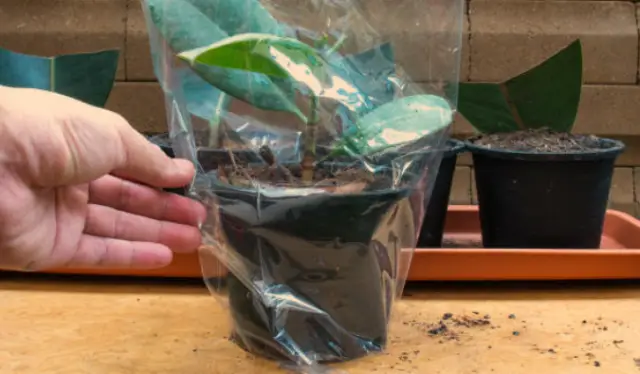
Step-by-Step Guide to Air Layering:
- Select a suitable stem. Choose a healthy, semi-hardwood stem that is at least 6 inches long and easily accessible.
- Prepare the layering site: Using a sharp knife, make a diagonal cut about one-third of the way through the stem, approximately 6 inches from the tip.
- Apply rooting hormone (optional): For faster root development, you can apply a rooting hormone to the cut area.
- Wrap the cut area: Pack the cut area with a handful of moistened sphagnum moss or a well-draining rooting medium.
- Secure the wrapping: Use plastic wrap or aluminum foil to cover the moss or rooting medium, ensuring it remains moist and creating a conducive environment for root growth.
- Monitor for root development: After several weeks, gently unwrap the layered area; if you see roots emerging from the stem, you can proceed to the next step.
- Separate the new plant: Once roots have formed, carefully cut the layered stem just below the rooted area, separating the new plant from the parent.
- Transplant and care for the new plant: Plant the rooted cutting in a well-draining potting mix and provide it with the appropriate care for its species.
3. Seed Propagation
While less common for indoor ficus plants, propagation from seeds is an option for certain species, particularly those grown outdoors or in greenhouse environments. This method can be more time-consuming and challenging, but it’s a fascinating way to observe the full life cycle of the ficus plant.
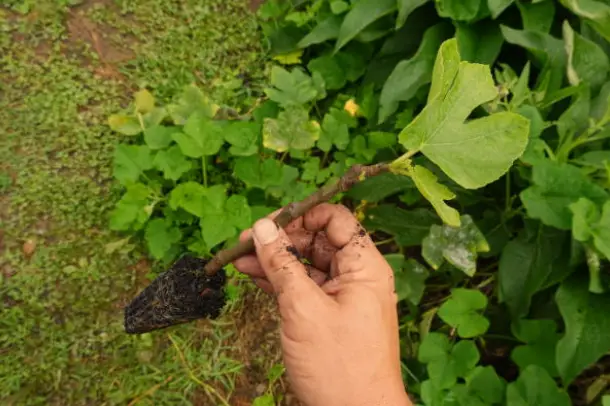
Ficus Plant Propagation
Step-by-Step Guide to Seed Propagation:
- Obtain viable ficus seeds: Ficus seeds can be collected from mature fruits (figs) or purchased from reputable seed suppliers.
- Prepare the seed tray: Fill a seed tray or container with a well-draining seed-starting mix.
- Sow the seeds: Gently press the seeds into the seed-starting mix, spacing them about an inch apart.
- Cover the seeds: Lightly cover the seeds with a thin layer of the seed-starting mix.
- Water and maintain moisture: Keep the seed-starting mix consistently moist but not waterlogged.
- Provide warmth and light: Place the seed tray in a warm, well-lit area, ideally with bottom heat to encourage germination.
- Monitor for germination: Depending on the ficus species, germination can take anywhere from a few weeks to several months.
- Care for seedlings: Once the seedlings emerge, provide them with adequate light, moisture, and gentle fertilization.
- Transplant and care for the new plants: When the seedlings are large enough to handle, transplant them into individual containers with well-draining potting soil and provide them with the appropriate care for their species.
Caring for Your Propagated Ficus Plants
Regardless of the propagation method you choose, providing proper care for your new ficus plants is crucial for their long-term health and vitality. Here are some general care tips:

1. Light Requirements: Most ficus plants thrive in bright, indirect sunlight. Avoid direct sunlight, which can scorch their leaves.
2. Watering Needs: Ficus plants prefer consistent moisture, but be careful not to overwater them. Allow the soil to partially dry out between waterings.
3. Humidity Levels: Ficus plants appreciate higher humidity levels, so consider using a humidifier or misting them regularly.
4. Temperature: Ideal temperatures for ficus plants range from 65°F to 85°F (18°C to 29°C). Avoid exposing them to drafts or sudden temperature changes.
5. Fertilization: During the growing season, feed your ficus plants with a balanced, water-soluble fertilizer every 4 to 6 weeks.
6. Pruning: Regular pruning can help maintain the desired shape and encourage bushier growth. Always use clean, sharp pruning shears.
You can have vivid, thick foliage and a flourishing indoor oasis with your propagated ficus plants if you follow these care instructions and provide them with the proper conditions.
Conclusion
Propagating ficus plants is a rewarding and cost-effective way to expand your collection of these captivating plants. Whether you choose stem cuttings, air layering, or seed propagation, the process of nurturing new life from an existing plant is deeply satisfying. Embrace the joy of propagation, share the beauty of ficus plants with your loved ones, or create a verdant sanctuary in your own home. With patience, attention to detail, and a little green thumb magic, you’ll soon be surrounded by thriving ficus plants, each with its own unique story and connection to the parent plant.

